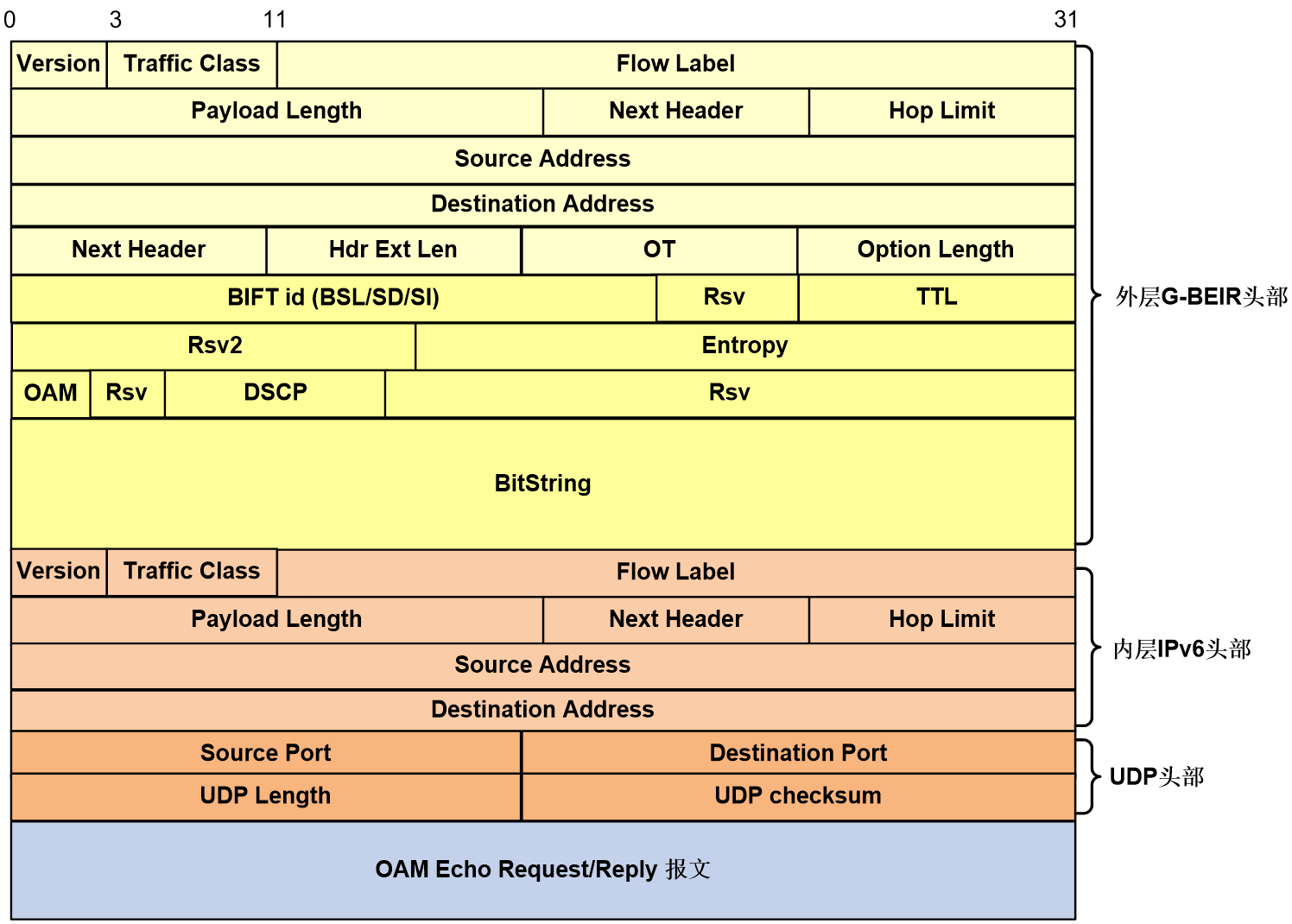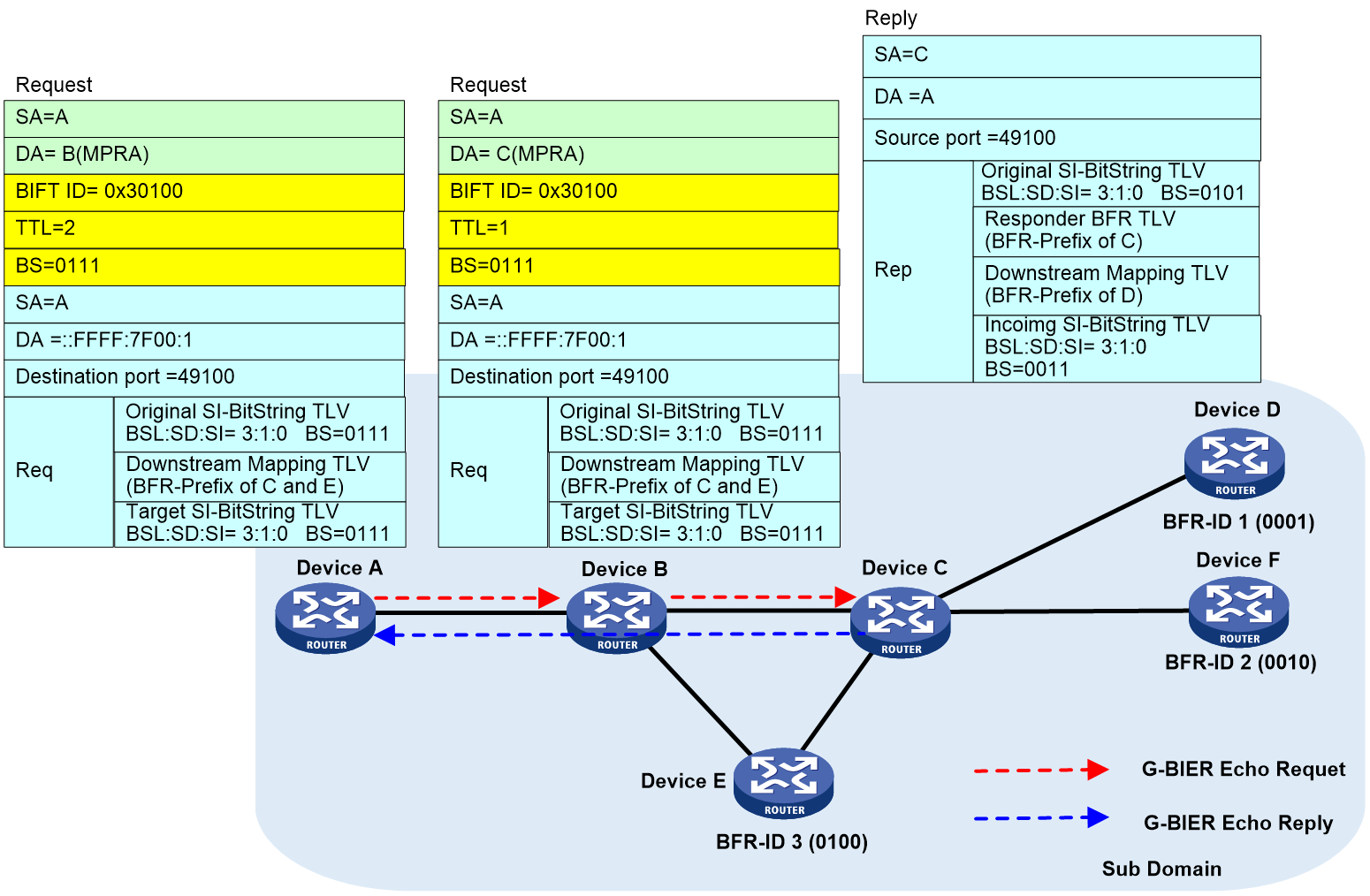- Table of Contents
- Related Documents
-
| Title | Size | Download |
|---|---|---|
| 02-BIER OAM configuration | 197.72 KB |
Contents
Configuring BIER OAM
About BIER OAM
G-BIER Operation, Administration, and Maintenance (OAM) uses ping and tracert utilities to test G-BIER network connectivity.
· G-BIER ping—Tests the reachability of destinations on a G-BIER network.
· G-BIER tracert—Tests the reachability of destinations on a G-BIER network and identifies the fault point on the G-BIER forwarding path.
G-BIER ping and tracert add three headers: a UDP header, an IPv6 header, and an IPv6 G-BIER header in sequence to an OAM echo request or reply and transmit it over a BIER tunnel.
G-BIER OAM uses a UDP port number (default 49100) to listen and receive request packets. Upon receipt of a request, the destination responses with a UDP packet.
G-BIER OAM packet format
G-BIER ping and tracert use G-BIER echo requests and replies for network diagnosis. Figure 1 shows the format of a G-BIER echo request or reply packet.
Figure 1 G-BIER OAM echo request/reply packet format
· G-BIER header: For detailed information about the fields in the G-BIER header, see BIER Configuration Guide.
· IPv6 header:
¡ Source Address—IPv6 source address, 32 bits in length. In a request packet, the value of this field is consistent with that in the G-BIER header. In a reply packet, the value of this field is the prefix of the destination BRF.
¡ Destination Address—IPv6 destination address, 32 bits in length. In a request packet, the value of this field is fixed at 0:0:0:0:0:FFFF:7F00:1. In a reply packet, the value of this field is the source IPv6 address of the request.
· UDP header:
¡ Source Port—UDP source port number, 16 bits in length.
¡ Destination Port—UDP destination port number, 16 bits in length.
¡ UDP Length—UDP datagram length, 16 bits in length.
¡ UDP Checksum—UDP checksum, 16 bits in length. It is used to verify the integrity of the transmitted data.
G-BIER ping
G-BIER ping tests routing underlay connectivity and can be performed only if the G-BIER routing underlay is established. It does not rely on any G-BIER-based multicast service configuration or the IPv6 source addresses that represent the MSIDs.
A node in a BIER domain transmits a G-BIER echo request packet to the destination BFER to initiate a ping test. After receiving the request packet, the destination BFER responds with a G-BIER echo reply packet. If the initiating node does not receive a response from the destination BFER node within the specified time, a timeout message is generated.
Figure 2 shows a G-BIER ping procedure. In this example, the packet is transmitted over the Device A→Device B→Device C→Device D path.
Figure 2 G-BIER ping
1. Device A determines the BIER triplet information (BSL, sub-domain, and SI) based on the ping command and identifies the BIFT ID, 0x30100 in this example.
2. Device A looks up BIFT 0x30100 and determines Device B as the next-hop adjacency. Then, it encapsulates the G-BIER echo request in a G-BIER header and transmits the packet to Device B. Within the G-BIER header, the destination IPv6 address is set to Device B’s MPRA, and BS is set to 0111.
3. Device B looks up the local BIER forwarding table and then forwards the packet to Device C.
4. Device C looks up the local BIER forwarding table and then forwards the packet to Device D.
5. Upon receipt of the echo request, Device D which is the destination node returns an echo reply packet to Device A.
6. Upon receiving the echo reply, Device A compares the key fields of the reply packet with those of the request packet it sent. If the fields match, Device A outputs reply information. If the fields do not match, Device A ignores the packet.
7. If Device A does not receive a response from the specified destination node within the specified waiting time, it outputs a timeout message.
G-BIER tracert
The G-BIER tracert uses the following process:
1. The source node sends BIER echo requests.
The source node sends the first echo packet with a TTL of 1 and increments the TTL by 1 on each subsequent transmission, until the destination responds or until the maximum TTL is reached.
2. Intermediate nodes processes the requests.
After receiving an echo request, an intermediate node forwards the request if the TTL is not decremented to 0. If the TTL decrements to 0, it returns code 5 (successful packet forwarding) if a forwarding entry exists and code 8 (no matching entry in the forwarding table) if no matching entry exists in the forwarding table.
3. Destination nodes respond with a BIER echo reply.
Upon receipt of an echo request, a destination node returns either of the following codes:
¡ 3 (Replying BFR is the only BFER in header Bitstring)—The destination node is the only BFER matching the bit string in the G-BIER OAM echo request header.
¡ 4 (Replying BFR is one of the BFER in header Bitstring)—The destination node is one of the BFERs matching the bit string in the G-BIER OAM echo request header.
A BFER will not be tested after it replies. The G-BIER tracert procedure is completed and G-BIER forwarding path information is provided only if all destination BFERs return code 3 or 4 or the maximum TTL is reached.
The subsections use the first and second tracert round trips as examples to describe the G-BIER tracert procedure.
First tracert round trip
Figure 3 First tracert round trip
1. Device A determines the BIER triplet information (BSL, sub-domain, and SI) based on the tracert command and identifies the BIFT ID, 0x30100 in this example.
2. Device A looks up BIFT 0x30100 and determines Device B as the next-hop adjacency. Then, it encapsulates the echo request in a G-BIER header and transmits the packet to Device B. Within the G-BIER header, the destination IPv6 address is set to Device B’s MPRA, TTL is set to 1, and the BFR prefix of Device B is carried in the Downstream Mapping TLV field.
3. After the request arrives at Device B, its TTL is decremented to 0, and Device B returns an echo reply packet to Device A. Because Device B is a transit node, the echo reply packet carries the BFR prefixes of downstream Device D and Device E in the Downstream Mapping TLV and the BFR prefix of Device B in the Responder BFR TLV.
4. Upon receipt of the echo reply, Device A compares key fields in the reply with those in the request it sent. If the fields do not match, Device A ignores the reply. If the fields match, Device A displays reply information.
Second tracert round trip
Figure 4 Second tracert round trip
1. Device A looks up BIFT 0x30100 and determines Device B as the next-hop adjacency. Then, it encapsulates the echo request in a G-BIER header and transmits the packet to Device B. Within the G-BIER header, the destination IPv6 address is set to Device B’s MPRA, TTL is set to 2, and the BFR prefixes (copied from the received echo reply) of Device C and Device E are carried in the Downstream Mappling TLV field.
2. Device B looks up the local BIFT and forwards the packet to Device C.
3. After the request arrives at Device B, its TTL is decremented to 0, and Device C returns an echo reply packet to Device A. Because Device C is a transit node, the echo reply packet carries the BFR prefix of downstream Device D in the Downstream Mappling TLV, and the BFR prefix of Device C in the Responder BFR TLV.
4. Upon receipt of the echo reply, Device A compares key fields in the reply with those in the sent request. If the fields do not match, Device A ignores the reply. If the fields match, Device A displays reply information.
Enabling G-BIER OAM
Restrictions and guidelines
Devices transmit G-BIER OAM packets over UDP. To avoid UDP port conflict between G-BIER OAM and other protocols, use the default UDP port number for G-BIER OAM packets.
For BFRs in a BIER sub-domain to receive G-BIER echo requests, specify the same UDP port number for the BFRs.
Procedure
To enable G-BIER OAM, execute the following command:
g-bier oam enable [ udp-port udp-port ]
By default, G-BIER OAM is enabled.
Performing G-BIER ping
Restrictions and guidelines
Before configuring this task, make sure G-BIER OAM is enabled.
If you specify multiple destination BFRs in this command, make sure all the BFRs are in the same SI.
After sending a G-BIER echo request, the device waits for the response timeout to expire before a subsequent transmission if the specified echo request transmission interval is less than the response timeout.
Procedure
To test reachability of one or a range of BFRs on the G-BIER network, execute the following command in any view:
ping bier g-bier sub-domain sub-domain-id bsl bsl-value bfr-id bfr-id-value [ to bfr-id-end-value ] [ -c count | -h ttl-value | -m interval | -t timeout | udp-port udp-port ] *
Performing G-BIER tracert
Restrictions and guidelines
Before configuring this task, make sure G-BIER OAM is enabled.
After a fault is detected by using the ping bier g-bier command, you can use the tracert bier g-bier command to locate the fault point on the network.
If multiple G-BIER ECMP paths exist between the source node and destination node, specify an entropy value for selection of a path.
Procedure
To trace the path that a G-BIER packet traverses from the source to destination, execute the following command in any view:
tracert bier g-bier sub-domain sub-domain-id bsl bsl-value bfr-id bfr-id-value [ to bfr-id-end-value ] [ entropy entropy-value [ to entropy-end-value ] | [ -ds | -h ttl-value | -ibs | -t timeout | -tbs | udp-port udp-port ] *





